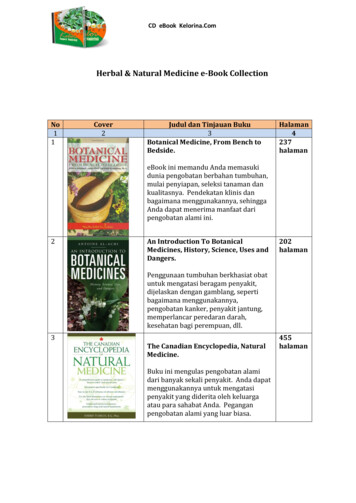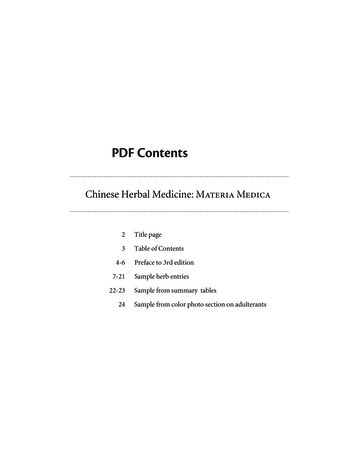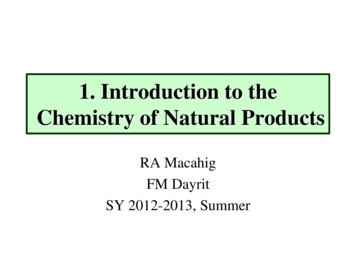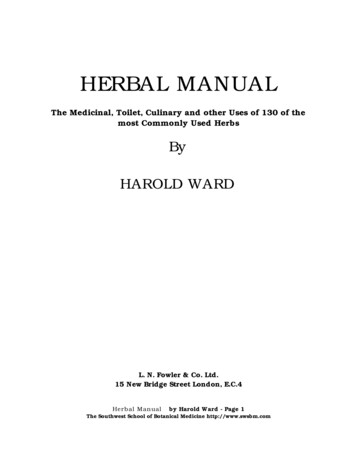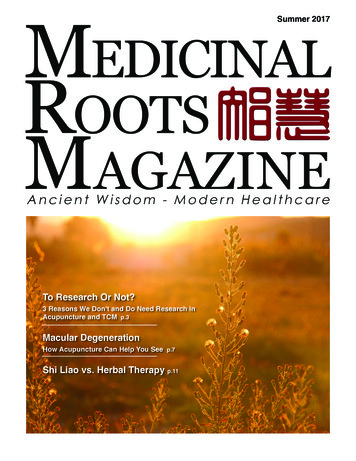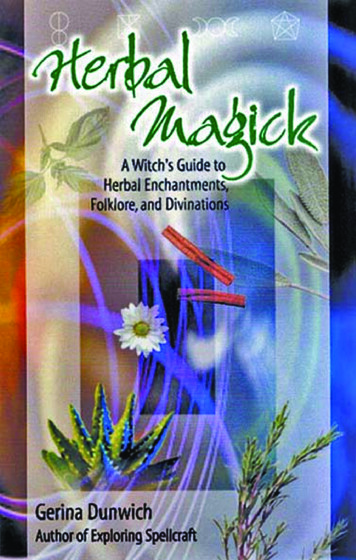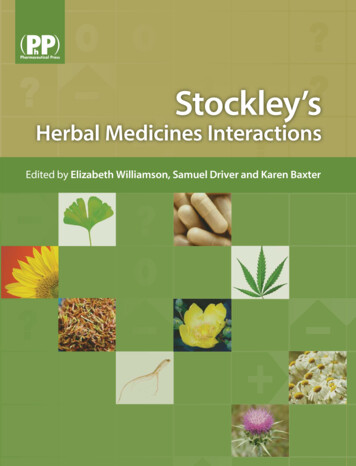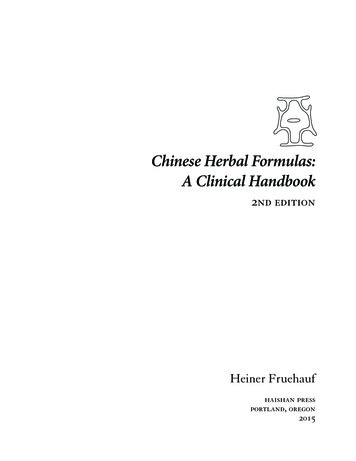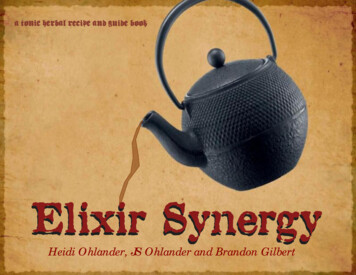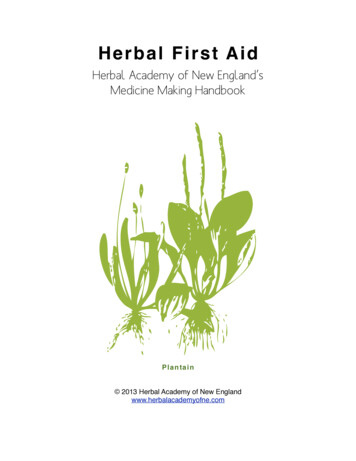
Transcription
He rba l F i rs t A i dHerbal Academy of New England’sMedicine Making HandbookPlant ain 2013 Herbal Academy of New Englandwww.herbalacademyofne.com
About HANEThe Herbal Academy of New England is an Educational Resource offering classes, workshops, herbal clinicsand weight loss counseling. The academy is also the home of Perch on Bedford Center, retail and wellnesscenter in Bedford, MA.The academy is committed to researching and gathering information and tools to help support a lifestyle ofself awareness and whole body care. We seek to encourage individuals and society to make sustainable andmeaningful changes so as to use earth’s resources with greater wisdom and respect. Herbalism includesstewardship of the earth.As an academy, we bring teachers and students together to learn and to share in an atmosphere of rigor and ofcommunity. We seek to encourage learners and teachers in serious study and exploration, both academic andexperiential.www.herbalacademyofne.com
GettingStartedEverything You Need To KnowMinus The Recipes!Herbalism, or phytotherapy, which is the use of plants to support the body’s own healing,is practiced by almost everyone in some way consciously or unconsciously.Herbal medicine has been carried down to us from generation to generation. This is mostdefinitely true for women who have traditionally been the food preparers and caregiversfor their families and communities. Women practice herbalism when they tend theirgardens, feed their families whole foods, or comfort the ailing with teas and other homeremedies. Cultures from the beginning of time and all around the world practice and relyheavily or solely on herbal medicine.Herbalism is nothing more than using whatgrows on the earth as food and as medicine.It’s Earth medicine.There are so many ways to use plants as medicine and we will dive into many of thesemethods in this handbook. We can eat them whole as food dried or fresh; consume themin vinegars and oils; drink them in teas, infusions, decoctions, cordials, and wine; andtake them in capsules, pills, tinctures, powders, extracts, and syrups. We can use herbsexternally as poultices, ointments, salves, liniments, creams, soaps, and lotions. We canmake toothpaste, shampoo, conditioners, bath salts, and medicinal oils. We can makesachets out of lavender, pine, rosemary, cedar or other aromatics to use for sleep. Thelist goes on and on.So it is here where we will begin the first process of creating an Herbal First Aid Kit. Wemust begin with the basics:Herbal Teas / Syrups / Herb infused oils / Salves and balms / Tinctures / Capsules andpoultices
Buying andGatheringHerbsWhat to lo ok fo r when b u yin g bulkher bs:G a t h e rin g He rb s : G ra t it u d e a n dRe s p e c tA certified organic seal. Organically grown herbs arehighly preferable to those sprayed with pesticides.Choosing organic is better for everyone.When you grow herbs in your garden or in pots, offerthem nourishment through organic methods. Fertilizethem with compost, kelp, compost tea, or alfalfameal; never use pesticides or herbicides to kill theweeds where you want to establish your garden.Sustainably wild-harvested. Plant populations can bedecimated from overzealous and unconscious wildharvesters.Tightly sealed lid. Air damages plant material. Apoorly sealed container may cause moisture to seepinside, causing mold growth.Vibrant, fresh-looking color. As dried plant matterages, it starts to fade. Herbs and flowers should bebright and vivid.Fresh, strong scent. Rosemary should smell likerosemary; peppermint should tingle your nose;chamomile should have a mild apple smell. Someherbs are naturally mild, but if something is 100%odorless, it is likely past its prime.Taste. Herbs have a wide range of tastes, includingbitter, earthy, sweet, pungent, sour, etc. As you gainexperience, you will grow familiar with the tastes andscents of your herbs.Plant medicine is often stronger when they grow incompetition with other herbs, what some call “weeds.”We know the truth, of course: the weeds are what weseek, for they make the best medicine.If planting near your home, plant raised beds locatedaway from the roof drip line to minimize exposure topotential roofing chemicals and contaminants.When wild harvesting, gather plants that are at least50 feet back from the edge of the road, never gathernear telephone lines (pesticides are usually sprayedalong this route), and please remember that you arevisiting the plants in their home. A few good mannerswill go very far in keeping alive abundant and thrivingplant populations for the next seven generationsbeyond us.
Herbal TeasTea is an infusion of plant material into water, and is asimple and soothing way to introduce healing compoundsinto our bodies. Gathering fragrant herbs from our gardensor kitchens and inhaling aromas of flower and leaf reconnectus to the living world. There’s something empoweringabout using our own hands to create remedies with thehumble tools of water, heat, and plants.While some herbs can be taken in their whole form,preparing an herb with a solvent, such as water, alcohol,vinegar, or glycerin, captures constituents from fibrousplant material that would otherwise pass through thebody. Quite simply, extracting plant constituents into aneasily absorbed medium grants our bodies easier accessto medicinal properties.Using water, the universal solvent, to make tea is a timehonored tradition of herbalism: a simple, enjoyable andeffective way to deliver the water-soluble properties ofplants.Decoction DirectionsA decoction is a slow simmer, reserved for tough rootsand hardy barks that require more time and work to extractconstituents.Many herbalists advocate soaking the herbs overnightprior to decoction to help soften the material.Infusion Directions An infusion is a steeping method, used for the more delicateparts of a plant such as flowers, stems, and leaves. Roots can be reused several times in a row before beingcomposted or discarded. Bring water to a boil in a teapot or pot (never usecopper, aluminum, or Teflon-coated pots or utensils).While the water is heating, crush herbs in your hand orwith a mortar and pestle to help weaken the cell walls.Place herbs in a ceramic cup, Mason jar, or teapot.Pour hot water over the herbs.Cover your vessel to prevent volatile properties fromescaping with the steam.After steeping, strain through a mesh strainer intoa clean container, pressing down on the herbs witha spoon to squeeze out as much liquid as possible.Another method is solar infusion, which employs heatfrom the sun to gently extract plant compounds. This willprovide milder results but there is something quite specialabout drinking sun-infused tea! Combine herbs and water in a glass jar, and covertightly.Place in a sunny spot for a few hours.Strain as directed above.Bring water and roots/bark to a boil in a covered potthen lower heat.Simmer for 20 – 45 minutes.Remove from heat, strain into heat-safe vessel.Decoction/InfusionIf your recipe calls for both leaves/flowers AND roots: Decoct the roots as instructed above.Meanwhile, place the leaves/flowers into a vessel(cup, jar, teapot).After 20 – 45 minutes decocting, pour herbs and hotwater over the leaves/flowers.sCoverandsteep.Tea is best consumed the day of brewing, but can also bestored in the fridge for 24 hours.ProportionsRecommended proportions vary from from herb to herb.For beverage teas, about 1 teaspoon of herb per cupof water is the norm, but medicinal teas are generallystronger. Use what works well for you. Some popularproportions are: 1 ounce of dried herb per quart of water1 tablespoon dried herb per 8 ounces water1/4 cup dried herb per quart water
SyrupsWith a lot of internal herbal medicines, we start off makinga tea. Syrups are no exception. The tea reaches highstrength when we concentrate it, usually decocting theblend over high heat so the water boils down and we areleft with a smaller amount of tea than we started with, at amuch higher concentration. Syrups will preserve for abouta year in the refrigerator if they are at least 20% honey orsugar. They are delicious and designed to take frequently.Making Syrup:The ratio – 1 pt concentrated tea by volume: 3 pts honeyby volume (sugar can be substituted) Begin with an herbal decoction or infusion that hasbeen reduced to about half or a third of the originalamount.Add three times as much honey (in volume) to a doubleboiler (or something you have fashioned yourself thatacts like a double boiler).Heat gently—honey is more fragile than sugar—avoid a simmer or boil. Then, stir into the tea until it iscompletely incorporated.Divide smaller portions into sterilized jars.At this point, you can add tincture and/or essential oils,cap jar and shake it to infuse the added medicine.A general rule of thumb is 1 tablespoon every 4 hours for adults, 1 teaspoon every 4 hours for children.
Herb Infused OilThere are a few ways to infuse oil with medicinal andnutritional herbs and we will go through them here. If youhave never made an herbal infused oil you are in for awonderful treat!Making infused oils is necessary for creating salves andbalms which will we introduce in the next section. Forbest results, use good quality dried herbs as they will notcontribute to spoilage and always use clean jars with tightfitting lids. Consider using colored glass bottles whichwill help extend the shelf life of your oil. We also suggestadding a few drops of vitamin E oil as it helps preservethe oil.Cold Infusion/Solar InfusionMaterials needed: Good quality dried herbOil (Olive oil is commonly used as it offers someresistance to oxidation and rancidity. Coconut, grapeseed, almond and apricot oils are also used)Natural wax paperClean, dry glass jar with tight fitting lidLabels and permanent markerVitamin E oil (optional)IntentionThe sun or a consistently warm areaThis is a folk method which means we are going to eye ballit and not measure or weigh. If you are more comfortableusing measurements, the ratio is approximately 1 ounce ofdried herb to 10 ounces of oil.Do not wash the herb or introduce any water to the processby using a wet jar or wet spoon for mixing. Fill the jar abouthalf full with the dried herb and cover completely with oilof your choice. Take a spoon or chopstick and gently stirthe mixture making sure that all the plant material is wellcovered with oil. Before putting on the lid, cover the topof the jar with a small square of natural wax paper thenscrew on the lid. The wax paper will prevent any harmfulchemicals that may be coating the inside of your lid fromcontaminating the oil.Heat is what helps infuse the oil so place the jar in a warmspot but not directly in the sunlight unless you are usinga dark colored bottle or jar. Take the jar in your handsand roll back and forth to make sure that the herb is wellsaturated with oil.Don’t forget to label!Just as we do in making herbal tinctures or wonderfulmeals for our loved ones you may want to add a goodintention here. Leave the oil steeping for 4-6 weeks. Besure to check on it every few days and give it a gentle rollback and forth. This helps to release the herbal propertiesand keeps everything well covered.After six weeks the oil will be ready to decant. Place acheesecloth lined strainer inside a large bowl with spout.Pour the content from your jar into the strainer. Gatherthe ends of the cheesecloth together and squeeze theremaining oil from the herb into the bowl. You’ll want tosqueeze hard to get every last drop! Pour the oil intoprepared bottles or jars and add a couple drops of vitaminE oil. Keep this oil in a cool, dark place. Most infused oilsgenerally last for a year or longer. Do be mindful of oilsgoing rancid and discard if it begins to smell off.Heat Infused OilPlace the herb and oil filled jar on a heat element suchas a hot plate or perhaps a radiator for 10 days. If usingthis method you will keep the jar open as this will promotewater evaporation. This heat source should not be warmerthan 125 degrees F. at any given time. After 10 days thisinfused oil can be decanted and stored following thedirections above.Stove top method for herb infused oils.Place the herb filled jar in a sauce pan that has been filledabout ¼ full of water, simmer for 4-8 hours. Remove jarfrom saucepan and allow to cool. Decant, bottle, label andstore in a cool dark place.Oven method for herb infused oils.Place the herbs and oil in a large oven proof dish andplace in a preheated 250 degrees oven. Turn the ovenoff and place the herb filled bowl in the oven for 24hours uncovered. Cool the mixture than pour through acheesecloth lined strainer into a bowl with a spout. Bottle,label and store following the instructions above.Double boiler method for herb infused oils.Place the herbs and oil in a double boiler and bring to aslow simmer. Slowly heat for 30-60 minutes. Keep the heatnice and low for a longer simmer time and to help releasemedicinal properties. Decant, bottle and store followingthe instructions above.
Salves and BalmsSalves are the consistency of lip gloss, resulting from the mixture of an oil infusedwith herbal material and beeswax. They are normally prepared as topical andexternal applications. They soften when applied to the skin, providing an emollient,healing base that protects the skin and nourishes the wound. Salves can be hardor soft, depending upon consistency desired by the creator.Sometimes a salve remains high in the delightful aroma of the herbs that areinfused into it—then it is called a balm. It is also acceptable to improve the smellof a salve with a few drops of essential oils as it hardens.Mix approximately 2 oz. of dried herb or a formulation of dried herbs into each cupof oil (almond, apricot, olive, sesame, etc.).Place this mixture into a ceramic container, uncovered and place into an ovenwith the door slightly open. Heat the mixture at a low heat for 3-5 hours (100-140degrees F). Periodically stir the mixture and check the temperature. Alternatively,place over low heat in a make-shift double boiler, or a pot of water which warms thereceptacle holding the oil so it can sufficiently warm to infuse the herbs into itself.Line a large strainer with three layers of cheesecloth.Remove the warm mixture and pour it into the strainer to separate out the herbs.Let this sit until well-drained and press out the remaining oil. Thank the herbs andcompost them (this will significantly impact the intensity of your medicine, for herbscan offer more when we treat them with honor!).You now have an infused oil. If you desire a salve, measure the amount of infusedoil you have at this point and re-warm in your previously chosen method.Add approximately 1 oz. of shaved beeswax per cup of oil to the oil infusion andmelt it completely.Dip a spoon into the formula and place it into a refrigerator so the salve will coolquickly and you can determine if its consistency is what you desire. If the sampleis too soft, add a little more wax to the warm salve; if the sample is too hard, add alittle more of the oil infusion.While warm, pour individual portions into appropriate containers and allow to cool.Then put the lids on and mark them with their names and ingredients. Enjoy!
TincturesTinctures are herbal preparations that use something beyond water as a solvent. By adding liquid to water, you can extracta greater spectrum of the whole plant and preserve the medicine much longer than an infusion or a decoction. Additions towater usually include alcohol, vinegar, and glycerin.Easy TincturesEffective tinctures are reliably made straight from the garden to the kitchen using only a few simple tools: a sharp harvestknife, cutting board, canning jars with lids, cheesecloth, and a bowl. Depending on the herbal parts you are using for yourtinctures, a coffee grinder or blender may speed the process but is not crucial. This method requires very little measuringand no weighing.Two basic parts combine to form the tincture: the menstruum, or liquid component which extracts and the herbal material.The herbs should be clean, vibrant, and have all unusable parts (like stems, fibrous seedheads, etc.) removed from themby garbling. Garbling is the action of herbalist to remove the unusable parts by stripping off the wanted parts of the herb intoa bowl. We discard the fibrous plant parts because they tend to have a lower concentration of medicinal qualities, as theyconsist mainly of insoluble fiber and water.How to make an easy tincture:(This process is adapted from Richo Cech’s explanation inMaking Plant Medicine.) Harvest and garble the fresh or dried herbs off of thestalks OR wash and rinse and scrub dirt off of freshlydug roots. Chop fresh herbs and grind dried herbs intothe smallest dicings to expose the most surface areafor the maceration—or mixing of herbal constituentsinto the liquid tincture part.Place the herbs in a glass jar labeled with their nameand the current date.Add vodka to cover the herbs and replace the lid.Place the jar in a dark room and shake every day.After one moon cycle, or a month to six weeks, strainthe mixture through several layers of cheesecloth intoa bowl or glass jar. It is often helpful to use a rubberband to affix the cheesecloth to the rim of the jar.Squeeze all of the possible menstruum out of the plantmaterial.Allow material to settle overnight and strain again, ordecant, through a smaller filter such as filter paper ora thin wire screen.Mathematical TincturingThis type of tincture making relies upon the use of a gramscale and a graduated cylinder. The clearest benefits tothis method include producing tinctures that can providemeasured consistency batch after batch after batch basedon the same measured recipe. To achieve consistencyfrom batch to batch, the herbs must continue to be ofdependably high quality.The weight-to-volume ratio is a helpful method in that itrelates the weight of the herb you are using to the volumeof alcohol you will steep it in.
How to use the Weight-to-Volume Ratio Method for tincture:STEP ONEWeigh the herbs once they’re garbled (in ounces), andrecord this weight in oz. on a scale. It will determine theweight-to-volume ratio for your tincture. Then chop orbreak up the herbs as best as possible.STEP TWO - Ratio:Herb:Menstruum Ratio: Measure the ratio to determinethe total amount of menstruum your tincture desires.So, if you have 5 ounces of burdock root and 25 ouncesof menstruum, you are making a 1 to 5 (1:5) tincture,because for every one part of herb (by weight) you areusing 5 parts of liquid (by volume). Fresh herbs do well at1:3, or 1:2. Dry herbs are usually 1:4 or 1:5, but really, youdecide. Just remember, the higher the volume number(V), the weaker the tincture. Thus, a 1:2 is roughly twiceas strong as a 1:4. This will affect the dose.Alcohol: Water Ratio: This ratio represents the proportionsof the liquids that devise your menstruum. We find thatcertain herbs produce a stronger tincture when they aresteeped in an alcohol that is more concentrated than40-50%, like vodka. We can obtain a higher alcoholpercentage by mixing pure grain alcohol, which is 95% or190 proof with distilled water until we obtain the correctpercentage. Stronger is not best for all herbs – some canbe damaged by too high of an alcohol content. The termfor the percentage of alcohol that the herb prefers to betinctured in is solubility.For instance, the basic menstruum for a dry herb consistsof 50% grain alcohol combined with 50% distilled water.The Alcohol:Water Ratio is expressed as 50A:50W. Ifglycerin is added to the formula, the ratio might look likethis: 50A:40W:10G, meaning 50% alcohol, 40% water, 10%glycerin. If your desired solubility is available directly froman alcohol ingredient, as is the case in the easy tincturingmethod, your ratio would consist of no added water andwould simply look like: 100A.Grain Alcohol consideration: Grain Alcohol is 95% alcoholand 5% water, and if making large amounts of tincture,you may want to consider the percentage factor into yourratio. Otherwise, it is just as well to call it 100% for smallbatches and remain very close to the exact intended ratio.Grain alcohol effectively preserves the tincture when thevolume of grain alcohol measures at or above 22% of thetotal liquid volume.Sample Weight:Volume Ratio Tincture Recipe:1. Take 10 ounces of passionflower leaves and measure50 ounces of menstruum at 50% EtOH (Ethyl Alcohol).Starting Ratio: for a 50A:50W tincture, as familiarratio–50mL A (.95 Grain Spirits):50W 47.5 mL A :50 W (this will not achieve the desired 50:50 ratio .solet’s figure the details from here) .2. 50mL (desired starting point for A) – 47.5 mL (truestarting point for A) 2.5 mL (extra amount of Aneeded)3. 50mL 2.5 mL 52.5 mL starting point of 95% EtOH4. Final Ratio: 52.5 A:50 W5. Now, 2.5 mL is a SMALL amount of liquid in the bigpicture, which is why we can ignore this detail in smallamounts of extract.
CapsulesWith the right tools and ingredients you can make freshand quality capsules in your own home!You will need vegetable or glycerin capsules, homegrownherbs (dried and ground to powder) or herb powder, anda capsule machine (optional). A capsule machine makesthe process of filling the tiny capsules much easier andquicker.Honestly, chewing is the most reliable method for agood, sticky paste-like poultice. Kids love to do it and feelempowered when they or their friend gets a bruise—theymarch right on over to the patch of yarrow and poultice itup for the healing!Crushed and Chewed Leaves:Harvest a small handful of clean herbs and either chop orchew them into a pulp. Now, don’t swallow.Keep your capsules in a dry and dark/cool place. A cabinetworks just fine. In the proper environment, capsules shouldlast up to 12 months.If you have chopped them, add a little water and mix so itappears paste-like. When you have sufficiently pulped theherb, spread it on the wound and leave it there for 10-30minutes until you feel or see relief.Crushed and Chewed LeavesThe following are some great direct crushed applicationherbs:The simplest of all herbal remedies, you can make thisright in the garden, field, or forest when in need of a littlefirst aid for a cut, scrape, or bruise. All you need is a littlewater or saliva and “voila!” you have potent plant medicine. Yarrow (Achillea millefolium)—moves blood and isexcellent topically for bruisesPlantain (Plantago major)—soothes bug bites andstings on contactCalendula (Calendula officinalis)—a topical vulnerary,heals cuts and scrapes
PoulticesA poultice is traditionally a variation on the crushed or chewed leaves and a lotmore water. The herbal material is made into a paste, using hot liquids. It is thenspread thickly onto cloths and applied, while hot, directly to the body. Moist heattransfers the virtues of the herbs to the body, and because the poultice relies uponmoist heat, it must be replenished every few minutes.Poultices have evolved in the world of herbalism into herbal matter with a hot orcold application. Most directly, a poultice is a warm, moist bath for the body torelieve pain and relax tissue.Various qualities of poultices can be garnered depending on what type of herb youuse:Emollient poultices supply warmth and moisture to relieve inflammation andencourage healing. Herbs for emollient poultices include: flaxseed meal, oat meal,bran, bread and milk. Plantain, marshmallow root or mashed vegetables such ascabbage, turnip, potato or carrot.Medicated poultices exercise a specific influence on the body apart from warmthand moisture and are used to penetrate inflamed lacerations, boils, abscesses, orinflamed glands. Choose plants with the following actions: astringents, styptics,vulneraries, anodynes, disinfectants.Rubefacients cause skin redness, which is a sign of their primary activity: movingthe blood by dilating capillaries and encouraging their action. These herbsdraw blood from deep within the body to the surface to relieve congestion andinflammation deep within. Stimulating herbs used for rubefacients include: mustard,ginger, cayenne, garlic, and rosemary.Making a Poultice:Put the chopped fresh herbs into a clean white cotton sock. Fill another sock andalternate using this sock while the first one is reheating.Tie the sock at the top and place it into a shallow bowl.Pour enough hot water over the filled sock to soak the dry herbs, or warm up thewet herbs.Knead the sock with your hands until it is hot but can touch the skin.Apply this poultice to the body area until it cools down.Continue warming the poultice over and over and reapplying it to the affected areauntil you have done this for 20-30 minutes.
BITESANDSTINGS
Prevention before remedy! One of our favorite recipes for the Herbal First Aid Kit is natural bugrepellant.Natural Bug Repellant Spray IngredientsAdapted from Frugally Sustainable.Ingred i e n t s 1 ounce witch hazel1 ounce grape seed oil30 drops citronella essential oils20 drops eucalyptus essential oils15 drops lemon essential oils15 drops lemongrass essential oils15 drops cedar essential oilsDirect i o n s Mix ingredients in a bowl.Pour into a small spray bottle and shake well.Spray every couple of hours.Apple Cider Vinegar Relief SprayDirect i o n sPour apple cider vinegar into a spray bottle. Spray to any area that itches for immediate relief.Bug Bite Relief PoulticeDirect i o n sMake a poultice or spit-poultice based on the steps in Chapter One with fresh plantain leaves.Apply the poultice directly to the area for instant relief.Raw HoneyDirect i o n sHoney works wonders on insect bites! Place a small amount to area and let it absorb. Reapplyas needed.
A Drawing SalveAdapted from Frugally Sustainable.For boils and insect bites.Ingre d i e n t s 1 1/2 cups olive oil infused with goldenseal, chickweed, and/or plantain1/2 cup castor oil1 ounce beeswax1/2 cup activated charcoal1/2 cup bentonite clay1 teaspoon of the following essential oils: clove, rosemary, lemon, lavender, andeucalyptusDirec t i o n s Using infused oils, combine with beeswax on a low heat until melted and remove fromheat.While still warm, add the remaining ingredients and stir until combined.Pour into containers and store in a cool, dark place.Apply the salve to affected area and bandage up to 12 hours. Reapply every two hoursuntil healed.
heat.While still warm, add the remaining ingredients and stir until combined.Pour into containers and store in a cool, dark place.Apply the salve to affected area and bandage up to 12 hours. Reapply every two hoursuntil healed.Cooling Aloe SprayIngred i e n t s 2 ounces aloe vera gel2 ounces lemon balm hydrosol5 drops peppermint essential oil5 drops lavender essential oilDirecti o n s Mix ingredients together.Pour into a 4-ounce bottle with spray nozzle.Apply as needed to bug bites, rashes, or sunburns.Store in refrigerator.Anti-Itch CreamA good recipe for bites, poison ivy and other skin problems.Ingred i e n t s 1 teaspoon sea salt1/2 teaspoon baking soda2 teaspoons bentonite clay12 drops of peppermint essential oilApproximately 1 tablespoon water (more or less until creamy consistency)Direct i o n s Combine sea salt, baking soda and bentonite clay in a small bowl.Add water and stir until creamy.Lastly, add in essential oil.Store in an airtight container and use within a week.Eczema TeaA seasonal or dietary change can often instigate patches of eczema. This tea approaches theimbalance internally by gently cleansing the lymph.Ingred i e n t s Equal parts: calendula, nettles, red cloverDirect i o n s Infuse herbs in 8 ounces hot water for 20 minutesDrink with raw honey throughout the day
MINORBURNSANDSUNBURN
Lavender E.O.Direct i o n sFor a burn or sunburn, apply a few drops of lavender essential oil directly to area. Repeat 3times a day or as needed.Calendula Spray for BurnsDirect i o n sIn a 4-ounce bottle with spray nozzle, fill to top with calendula hydrosol and 15 drops of lavenderessential oil. Add in 5-10 drops of calendula tincture. Shake well and use as desired for burnsand rashes.Plantain Burn SprayDirect i o n sMake a plantain infusion with boiling water and a small handful of plantain leaves. Combine 1teaspoon of chamomile essential oil with infusion in a small bottle. Cool and then apply to burnsas needed.Yellow MustardDirect i o n sApply cold yellow mustard to burn and wrap with gauze.
Oatmeal BathIn g re dients 2 cups plain oatmeal, blended to finer grains3/4 cup lavender flower1/4 cup baking soda2 tablespoons green tea leaves1 cup milk (optional)In g re dients Add dry ingredients to cheesecloth and tie off.Fill bath with warm water and add milk (optional).Add cheesecloth mixture to the bath and soak.Topical Diaper Rash OintmentAdapted from David Hoffman’s recipe in Medical HerbalismThese herbs help to nourish and soothe the skin while keeping it dry and are antibacterial.Comfrey root actually grows new tissue on the surface of the skin, and in addition to chickweedand marshmallow root, it contains oodles of calcium. Goldenseal powder is a topical antiseptic.Apply ointment to diaper area after changing. If there is no response after 3 – 4 applications,other factors such as diaper disinfection, diet, and skin disorders should be considered.In g re dients 1 tablespoon chickweed1 tablespoon marshmallow root1 tablespoon comfrey root1/8 tablespoon goldenseal or barberry root powder1 cup almond oil¼ cup beeswax8 drops lavender essential oilD ire c tions Place sweet almond oil in a pan with the herbsGently heat for 5 to 10 minutes, be careful not to let herbs scorch or burnWhen mixture is hot, add the wax and allow it to meltAfter wax is melted, strain mixture through cheesecloth in a jar with a tight-fitting lid(don’t forget to label!).Place in fridge until mixture solidifiesStore away from heat near infant’s changing areaDiscard used portions after 2 months (Ho
So it is here where we will begin the first process of creating an Herbal First Aid Kit. We must begin with the basics: Herbal Teas / Syrups / Herb infused oils / Salves and balms / Tinctures / Capsules and poultices Herbalism is nothing more than using what grows on the earth as food and
